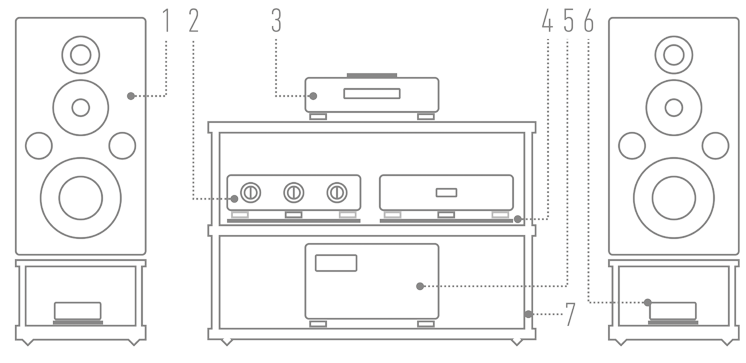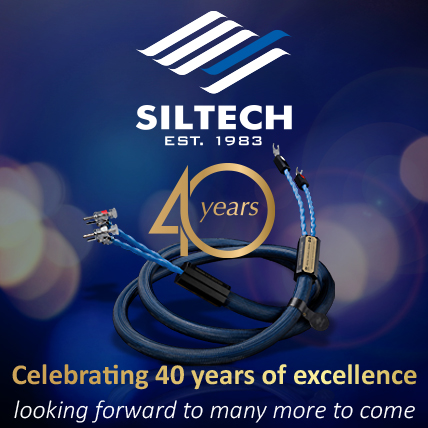|
POWER AMPLIFIER DIVALDI
Manufacturer: MEDIAM |

|
Review Text by WOJCIECH PACUŁA Images by „High Fidelity”, Divaldi |

|
No 257 October 1, 2025 |
|
˻ PREMIERE ˼ ⌈ The DIVALDI brand was established in 2010 on the initiative of Włodzimierz Duval, who invited his childhood friend Waldemar Łuczkos to join the project and work together after 30 years of working separately. The name DIVALDI combines two words – Dival (the phonetic pronunciation of the surname Duval) and Valdi (as everyone calls Waldemar Łuczkos). Today, the brand is represented by a team of several people: Waldek Łuczkos, Wojtek Markowski, Jurek Sołtys – under the leadership of Włodzimierz Duval. We are testing its latest product, the GOLD PA ONE power amplifier. ⌋ There are many AUDIO COMPANY DEVELOPMENT STRATEGIES, and they all seem to be equiva-lent. In the sense that each of them must be tailored to the profile of a given manufacturer, their views on audio, skills, financial, spatial, and organizational capabilities, and even temperament. Small changes at the “input” result in big changes at the “output” – this applies not only to audio equipment, but also to entire com-panies. 
One option is slow development and introducing new products as the company's capabilities grow and new products are developed. It usually starts with one product, which is then joined by others, creating either a whole series or a set of different lines. There are plenty of examples of this type of activity, such as Audio Re-veal, which periodically releases a new amplifier model, or More Audio with its integrated amplifier, the CS100, which, following its success, will be followed by a preamplifier and power amplifier (test → HERE. However, if financial resources allow and the company has been present on the market for some time, it is pos-sible to add a whole new line to the offer. This was the case with Divaldi's Gold series. In 2024, it was presented in its entirety at the Audio Video Show, with the Int One integrated amplifier, Pre One preamplifier, PA One stereo power amplifier, and Phono Stage phono preamplifier. However, plans are just plans, and life tends to verify them. As Waldemar Łuczkoś, the company's chief design-er, said at the time, the first thing to be developed was the power amplifier, which had been tested in-house and among audiophile friends for over a year. He told the Info Audio portal at the time:
And yet... Due to problems related to the production of the complex amplifier chassis, we had to wait until this year for the official premiere of the integrated amplifier, and until now for the launch of the power amplifier. The preamplifier, on the other hand, is still in the final testing phase because, as Waldek said, it is the most difficult component of an audio system to design. ▲ A few simple words WŁODZIMIERZ DUVAL 
IMPORTANT FEATURES OF THE AMPLIFIER include its class A operation with variable current stage bias saturation and an option of bridged operation. The amplifier is powered by two separate power supplies for the left and right channels. They utilize a capacitor bank with a capacity of approx. 100,000 μF. With this solution, the amplifier's operation at medium and high power levels is not dynamically limited. At full amplifier load of 2 x 90 W (at 8 Ω), there is always a huge reserve of energy for hard low-frequency slams. 
It is worth paying attention to the amplifier operating mode we have used. Class A with variable bias saturation of the current stage is characterized by the fact that in this current operating regime, the output stage does not lose a significant amount of power to temperature, and also ensures the correct operation of the power drivers in a wide range of supplied current (for each load). The power amplifier uses a Low Global NFB. With such operating circuits, this amplifier provides free and controlled tracking of output signals, especially in variable load current matching conditions, particularly at higher power levels. This is important because other Class A circuits typically have problems with instantaneous current efficiency in critical transient states. 
An innovative solution in our devices is the use of high-quality isolation transformers in the input stages. Thanks to them, the device achieves better signal transmission matching. The inputs are active and symmetrized for balanced XLR and unbalanced RCA inputs. The radiators are made in an innovative horizontal arrangement, unseen in any other design of this type in the world. The heat sink is a hand-assembled stack of aluminum plates with a large copper element at-tached to it, and then control and power transistors are screwed onto it. This solution ensures perfect heat dissi-pation and allows all key components to operate in the same operating regime, which increases the amplifier's resistance to temperature drift. 
The amplifier is equipped with automatic control supervising the operation of the power stage. The speaker outputs are switched on by relays with a delay and switched off immediately in case of overload. WD ▌ Gold PA One PA ONE IS A STEREO POWER AMPLIFIER, whose internal design is almost identical to that of the Int One integrated amplifier. However, this does not mean that it is identical. The appearance is also very simi-lar, because apart from the front and rear panels, the design of the chassis is identical. When talking about this device, I will therefore have to refer to the description we already know from the integrated amplifier test. 
The amplifier is a really large, very solid device. It measures 463 x 450 x 130 mm and weighs almost 50 kg. It offers 90 W per channel in floating class A at 8 Ω and 130 W at 4 Ω. The output peaks reach 180 and 250 W, respectively. What's more, the amplifier can be bridged, thus transforming into a monoblock with an output of 380 W at 4 Ω and 280 W at 8 Ω. The manufacturer states that the circuit uses “minimal negative feedback.” There are two inputs, RCA and XLR, and they are transformer-coupled, as is the case with studio and stage equipment. The output stage in the PA One operates in a push-pull configuration, and the device is a dual-mono design, with separate transformers for each channel. Although the PA One is not a classic Class A amplifier, a large part of the initial output is in class A. Its heat sinks are therefore really large. And they make a really strong impression. It is thanks to its mechanical construction that the Gold series owes something that companies have been work-ing on for many years – individual character or as the English-language press refers to it as identity). As we wrote when testing the Int One integrated amplifier, the manufacturer decided at the very beginning of its activity that the design of its products would be different from what we know from the world of audio. Read: re-fined and stylish. The modification it proposed seemed simple, but resulted in an unexpectedly interesting shape for the devices. Instead of straight side panels, they are cut out of a circle, resulting in a shape similar to a “sta-dium”. This worked well in the small products with which the company started its business, headphone amplifi-ers and phono preamplifiers, but in such large units as the tested amplifier, something else had to be add-ed. The first attempt to address this issue took place in the INT-01 model and was further developed in Int One. It was a design with a horizontal ribbed shell and vertical ventilation channels, with stacked elements milled from an aluminum profile. The result was an almost sculptural structure that also meets the basic re-quirements for the chassis: it provides mechanical stability for electronic systems, protects them from EMI and RFI (electromagnetic and high-frequency) interference, and, above all, efficiently dissipates heat from active components – output transistors. Same as with the success of the Evo series by Fezz Audio, also in this case a professional is responsible for the design of Divaldi devices. This is Piotr Jegiełłowicz, who runs the Jagiellowicz Design studio and col-laborates with the company. Let us remind you that he has won many awards, including Red Dot in 2015, 2018, and 2022, If Design Award in 2016 and 2017, and A' Design Award in 2023. His design for the Gold series as-sumes that the horizontal ribs in PA One are made of gold-anodized aluminum plates, which looks per-fect. 
The PA One's design is clean, yet not boring. It's a power amp, so we won't see any controls on the front panel except for the power switch (the second, main switch is located next to the IEC socket). But even such a “detail” looks professional; the white frame integrated into it is discreet but visible. The front of the device is made of tempered, smoked glass, reminiscent of McIntosh devices and Polish Circle Labs products. |
The rear panel is also nicely designed. It features single, solid speaker connectors by the German company WBT, in a gold-plated version, as well as XLR and RCA inputs. Nearby, there is a mechanical switch that allows you to set the amplifier to stereo or mono mode. The whole design is truly impressive. ▌ SOUND HOW WE LISTENED • The Divaldi Gold PA One power amplifier was tested in the “High Fidelity” reference system and compared to the Soulution 710 transistor power amplifier. In both cases, the preamplifier was the Ayon Audio Spheris Evo tube preamplifier. The signal to both devices was carried by unbalanced Siltech Royal Single Crown interconnects. During the test, the device stood on its feet on the upper carbon shelf of the Finite Elemente Pagode Edition Mk II rack. 
I used the Ayon Audio CD-35 HF Edition SACD player and the Sforzato PMC-05 EX file player with the DSP-05 EX master clock as my sources. The signal between the SACD player and the preamplifier was transmitted via a Siltech Triple Crown RCA interconnect, and from the file player via a Siltech Royal Single Crown cable; both interconnects were unbalanced. The amplifier was powered by a Harmonix X-DC350M2R Improved-Version cable, and the signal to the speakers was delivered by a Crystal Cable Da Vinci speaker ca-ble. The Divaldi PA One drove Harbeth M40.1 speakers. » ALBUMS USED FOR THE TEST ⸜ a selection
⸜ THE MILLS BROTHERS, The Early Mills Brothers, Finest Recordings/Tidal, FLAC 24/96 ⸜ 2000. I DON'T KNOW IF IT CAME ACROSS STRONGLY ENOUGH in the Gold Int One integrated amplifier test: Di-valdi devices combine speed with rich colors. But neither does speed turn into nervousness with them, nor does the rich color palette blur the details and differences between them. And you can hear this not only with powerful rock recordings, but also in the simplest – seemingly – mono recordings. 
˻ 1 ˺ Paper Doll by THE MILLS BROTHERS will surprise every-one who thinks that this type of music only sounds good when played from vinyl records through a tube ampli-fier. I played this track from a file player, streaming through a transistor power amplifier, and the effect was excellent. This brilliant track was recorded on February 18th. 1942, as the B-side of the then-new single (shellac record) I'll Be Around and was initially disliked by Herbert, but liked by Donald (both of whom were the Mills brothers). As they say, it took less than fifteen minutes to record. It is the warm, organic sound that we love crooners and good recordings from the 1940s for. The Polish amplifier presented them in a full and dense manner, which only intensified this feeling. It revealed the full rich-ness of the lower midrange. At the same time, it accurately highlighted the production defects, with strong thumps at the bottom of the band, originally inaudible to the turntables of the time. Today, after transfer and digital remastering, this is obvious, as is the patinated sound of SEASICK STEVE's contemporary recordings from the album Blues in Mono, for example ˻ 4 ˺ Wel Well Well. The amplifier builds strong phantom images on the listening axis. And in a way, this will be the most important axis with this amp. The spatial effects are organized, clear, and, when necessary, enveloping. As in the new cover of the song ˻ 1 ˺ Happy Together performed by SU-SANNA HOFFS and RUFUS WAINWRIGHT. The space here has been greatly expanded to really surround us. PA One slightly corrected this by pulling the stage deeper and further back. As I said, the omnidirectional effects were nice, cool, but it was the vocals in front of me that seemed most important to me. That is why everything that is shown in the foreground is so dense, so tangible. But it is not about bring-ing the sound forward. The tested amplifier plays with a slight breath, it does not bring the foreground closer. Due to the tightness of the sound and the precise rendering of the soundstage, the vocals seem clearer, cleaner, and larger than with most other devices in this class. It was like when I returned to mono recordings and played the duet by Ella Fitzgerald and Louis Armstrong from the album Ella and Louis, remastered by First Im-pression Music. Both performers had plenty of space for themselves, but they did not compete with each other or with the band behind them. Even the piano, usually slightly hidden, had a clear attack and was active, not just an-other element of the background. This is despite the fact that the PA One is not a device that directs sound to-wards clarity. It does not emphasize the contours of the sound. I would even say that there is a slight warming in its sound – if we were to look that deeply. It is not obvious or striking, but when we listen to Fitzgerald in ˻ 2 ˺ Moonlight in Vermont, we can feel it perfectly. And even Armstrong's trumpet, which follows, slightly sharp and powerful, seems to be “led” towards sweetness. And then there is the trumpeter's voice – low and dense! The Polish amplifier seems to love vocals and presents them in a big and powerful way, yet warm at the same time. But not “too warm”. This is not a device that simulates “tube sound”. Here, the warmth comes from within the sound, from its resolution and the elimination of nervousness. When Toshio Osumi hits the cymbals at the beginning of ˻ 1 ˺ Another Holiday, we hear a powerful crash. But it is also dense and deep. This track comes from the TSUYOSHI YAMAMOTO TRIO’S What a Wonderful Trio! recorded at Onkio Haus Studios in Tokyo by the team responsible for the sound of the Three Blind Mice label – Takeshi “Tee” Fujii and Yoshihiko Kannari. And TBM albums take no prisoners in this respect... (more about the TBM label → HERE). 
But in this powerful performance, where the foreground was dense and large, and the reflected sounds were a touch “dusty”, there was no exaggeration towards any direction. The intensity of the presentation was preserved, the energy transferred, and the colors filled. That's why I also enjoyed listening to the BILL EVANS TRIO album Waltz For Debby so much. I have several versions of this title, but this one, released in 2023 in Japan on SHM-SACD, is unique. Warm, low, full. But also clear and incredibly natural in expression, which the Polish amplifier transferred very well to my room. ▌ Summary AND THESE ARE THE ELEMENTS WE FIND in the sound of the Divaldi Gold PA One amplifier. It is a device that, in terms of tone and effortlessness, plays like a small tube amplifier – in terms of intimacy – or a small class A transistor amplifier – in terms of “breath” and lack of distortion. At the same time, it is faster and has greater dynamic reserve. That is why it does not sound nervous, because it does not have to – it is as if it knows that it has as much power headroom in reserve as it needs. At high volume levels, with heavily com-pressed material, it may not sound entirely “agreeable,” but rather more “prickly.” However, this will be a prob-lem with the recording, not with the amplifier. With good recordings and releases, the Divaldi amplifier will play in a very orderly manner. Its impres-sive size, power, power supply, etc. – all of this contributes to the sound, but it is secondary to the tone and full-ness. So when I finally returned to the monophonic recordings and Armstrong's vocals, this time from the album Wonderful World on UHQCD, I sat back deeper and more comfortably on the couch, stretched out my legs, and folded my hands on my stomach – a typical “relaxed” position. I wish the same for you, because it's wonderful to be able to listen to music this way. ▌ DESIGN THE DIVALDI GOLD PA ONE POWER AMPLIFIER has an unusual shape. It is not a cuboid, because the side panels are rounded. This enlarges the outline of the amplifier and makes it a substantial device that will stand out even on a large audio rack. The rounded elements are part of the heat sink design, composed of flat elements forming a characteristic horizontal comb with holes cut out to form vertical “chimneys.” The amplifier, it should be added, stands on four aluminum feet. FRONT AND BACK • The front of the device is made of tempered, smoked glass. Its panel is screwed to an aluminum chassis, which is really rigid. There is only one element on the front – the power switch. When turned on, it shows a white backlit frame. It is quite small, and the button goes quite deep in, so it is best to use your little finger to operate it. The rear panel is minimalist – after all, it is a power amplifier. The signal is fed to Neutrik balanced or unbal-anced connectors. The RCA connectors are mounted in XLR-shaped forms, which simplifies construction work. All connectors are gold-plated and Teflon is used as the dielectric. The WBT speaker connectors are also gold-plated. The only thing missing is a terminal for external artificial ground. INSIDE • This is a dual mono design. Each channel features a sepa-rate power transformer, power supply, and power amplifier screwed vertically to the heat sink. Three small boards are shared – an input board with RCA and XLR sockets, an output board with protection and relays, and protection in the power supply. The former is shielded with thick sheet metal. There are relays on the input board, the XLR sockets have been soldered to and RCA connected to via cables. Small permalloy-shielded boxes are also located on it. These are input transformers. They allow the input to be loaded in the manner required by the circuit and, at the same time, desymmetrize the signal from the XLR inputs. Although the device features inputs of this type, the circuit is asymmetrical. The transformer hous-ings feature the Divaldi logo on them, but they look like a product of the Swedish company Lundahl Trans-formers. The output stages are located on both sides of the amplifier. It is a transistor circuit with six pairs of transistors operating in push-pull mode, in floating class A. They are attached to copper plates, which are then at-tached to an aluminum heat sink. The inputs and output stages are connected with interconnects. These are MC-100 microphone cables from the Polish company Red's Music, made of 99.96% OFC copper, shielded with a copper braided screen with added silver. 
As we have already mentioned, the power supply looks very serious. It features two large toroidal trans-formers, one for each channel. Unlike in an integrated amplifier, where they are screwed on top of each other, here they are placed side by side – since there is no preamplifier section, there was enough space for that. To separate them from the housing, they were screwed not to the bottom panel, but to an additional rail that stiffens the structure. The rectifier bridge and capacitor boards were also mounted on separate rails – eight large and four smaller ones per channel. Let me repeat it: truly impressive. ● ▌ Technical specifications (according to the manufacturer)
Class of operation: A 
THIS TEST HAS BEEN DESIGNED ACCORDING TO THE GUIDELINES adopted by the Association of International Audiophile Publications, an international audio press association concerned with ethical and professional standards in our industry, of which HIGH FIDELITY is a founding member. More about the association and its constituent titles → HERE. |

|
Reference system 2025 |
|
 1) Loudspeakers: HARBETH M40.1 |REVIEW| 2) Line preamplifier: AYON AUDIO Spheris III Linestage |REVIEW| 3) Super Audio CD Player: AYON AUDIO CD-35 HF Edition No. 01/50 |REVIEW| 4) Stands (loudspeakers): ACOUSTIC REVIVE (custom) |ABOUT| 5) Power amplifier: SOULUTION 710 6) Loudspeaker filter: SPEC REAL-SOUND PROCESSOR RSP-AZ9EX (prototype) |REVIEW| 7) Hi-Fi rack: Hi-Fi rack: finite elemente MASTER REFERENCE PAGODE EDITION Mk II, more → HERE |
|

|
Cables Analog interconnect SACD Player - Line preamplifier: SILTECH Triple Crown (1 m) |ABOUT|» ANALOG INTERCONNECT Line preamplifier → Power amplifier: Siltech ROYAL SINLGE CROWN RCA; review → HERE Speaker cable: SILTECH Triple Crown (2.5 m) |ABOUT| |

|
AC Power Power cable | Mains Power Distribution Block - SACD Player: SILTECH Triple CrownPower (2 m) |ARTICLE| » POWER CABLE Mains Power Distribution Block → Line preamplifier: Acoustic Revive ABSOLUTE-POWER CORD, review → HERE » POWER CABLE Mains Power Distribution Block → Power amplifier: Acoustic Revive ABSOLUTE-POWER CORD, review → HERE Power cable | Power Receptacle - Mains Power Distribution Block: ACROLINK Mexcel 7N-PC9500 (2 m) |ARTICLE| Power Receptacle: Acoustic Revive RTP-4eu ULTIMATE |REVIEW| » ANTI-VIBRATION PLATFORM under Acoustic Revive RTP-4eu ULTIMATE: Graphite Audio CLASSIC 100 ULTRA, review → HERE Power Supply Conditioner: Acoustic Revive RPC-1 |REVIEW| Power Supply Conditioner: Acoustic Revive RAS-14 Triple-C |REVIEW| Passive filter EMI/RFI: VERICTUM Block |REVIEW| |

|
Anti-vibration Speaker stands: ACOUSTIC REVIVE (custom)Hi-Fi rack: finite elemente MASTER REFERENCE PAGODE EDITION Mk II, more → HERE Anti-vibration platforms: ACOUSTIC REVIVE RAF-48H |ARTICLE| » ANTI-VIBRATIONAL FEET: |

|
Analogue Phono preamplifier: Phono cartridges:
Clamp: PATHE WINGS Titanium PW-Ti 770 | Limited Edition Record mats:
|

|
Headphones » HEADPHONE AMPLIFIER: Leben CS-600X, review → HEREHeadphones: Headphone Cables: Forza AudioWorks NOIR HYBRID HPC |
main page | archive | contact | kts
© 2009 HighFidelity, design by PikselStudio,
projektowanie stron www: Indecity
















